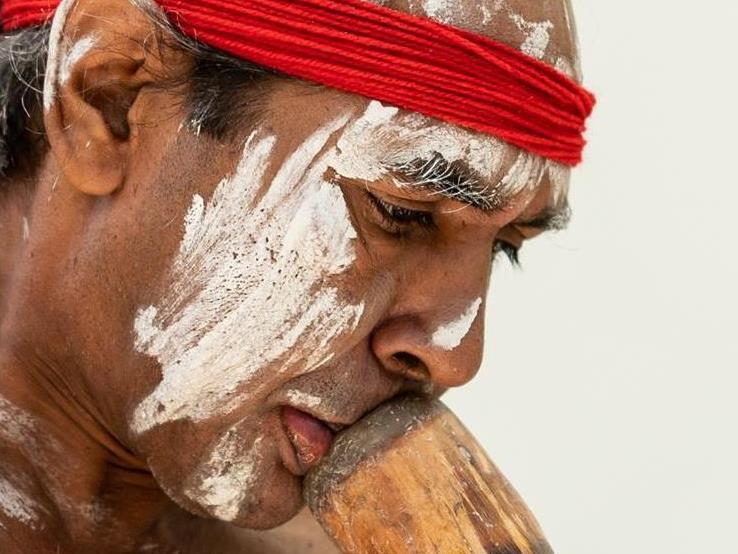Gulaga Dancers at Four Winds Festival. Photo by Warren Purnell.
On Easter Saturday and Sunday, the Four Winds Festival was blessed with perfect weather for its mainstage performances in the Soundshell, a natural outdoor auditorium. A further blessing came on Saturday evening in the form of an orange harvest moon that rose from the ocean, shining through eucalyptus trees.
From the very start this Festival’s engagement with the Indigenous community has been genuine and true, sensitive to the connection of the land on which it takes place. I know of no other Australian festival that celebrates this connection more strongly. Accordingly, Soundshell Saturday commenced with a ‘Welcome to Country’ starting with a sincere and unscripted spoken welcome in Djiringanj dialect and English by Iris White, a Yuin Elder.
In this introduction we were informed that the nearby 806-metre Mount Gulaga has particular significance for Yuin women. Representing a place of cultural origin, its peak is often shrouded in cloud thought to represent a warming white possum coat for ‘the mother’. Its later name of ‘Mount Dromedary’, now replaced, was given by Captain Cook who likened it to the shape of a camel’s hump. To the south is Mount Biamanga, a traditional ceremonial place reserved for men. In between the two mountains the Four Winds Festival site sits on a sacred Song Line.
There followed full acknowledgement of the people of the traditional lands; ancestors, Elders past, present and especially the young, powerfully identified here as ‘our future’. Thereafter came a performance by Warren Foster (didgeridoo) and the Gulaga Dancers, this year all males. Paths and the stage of the Soundshell were swept with eucalypt branches by men and boys (including one totally engaged infant) to bless the Festival accompanied by didgeridoo.
This Four Winds Easter Festival was the first in its newly restored annual cycle. In addition, an annual Youth Festival, the first of which took place last November, is planned to maintain cultural momentum throughout the year at the site. There were several musicians from the 2018 Youth Festival involved in this year’s Easter Festival, building on Four Winds’ commitment to developing young artists.
Sound Shell Saturday commenced with a ‘big band’ version of Ross Edwards’s Tyalgum Mantras. Here a ‘more-is-more’ misinterpretation included the ANAM orchestra with James Crabb on classical accordion, while 10 percussionists – situated behind the audience – played hand-held Suzuki tone chimes in place of crotales. With saxophone, horn, trumpet, cello and classical accordion needlessly added to the scoring amongst others, the work became a way-too-long improvisation over didgeridoo drone, sounding almost like a tune-up for the orchestra in Gregorian Mode. Riley Lee (shakuhachi) was noticeably absent.
A spunky performance of Israeli Lior Novok’s Tetris for ten winds followed, played by Arcadia Winds and the ANAM Wind Quintet. There was a fastidious rhythmic charge here in the work’s ascending metrical shifts and displacements. More or less a ‘display work’, this was an attractive inclusion to the program, though I suspect that it was probably more engaging to play than listen to.
Elena Kats-Chernin, a featured composer of the Festival, then led a performance of her filmic Crossing the 38th Parallel. My concerns began with the insensitive orchestration for paired saxophone and shakuhachi with their different tunings and unidiomatic writing for the latter, but I also pondered the substance of this certainly decorative but insubstantial composition. Nonetheless, it was enthusiastically received by the audience.
The highlight of Soundshell Sunday was Beethoven in the Bush, a performance of ANAM musicians led by the Australian String Quartet and guests, Stefan Vladar conducting. The ANAM orchestra was already a reasonably tight ensemble benefiting from its full-time tuition and performance schedule in Melbourne and enhanced here by the veteran experience of the Australian String Quartet leading the string desks.
Vladar’s conception for both Beethoven’s Coriolan Overture and the Piano Concerto No 3, where he performed both as soloist and conductor, was succinct and clearly shaped. In the Concerto a close rapport established between soloist and ensemble gave pleasure, especially in the second movement Largo, appropriately accompanied by the dusk calls of three birds in balletic flight above us.
3 stars out of 5: ★★★
2019 Four Winds Easter Festival
Soundshell Saturday and Sunday
Saturday 20 April and Sunday 21 April, 2019





